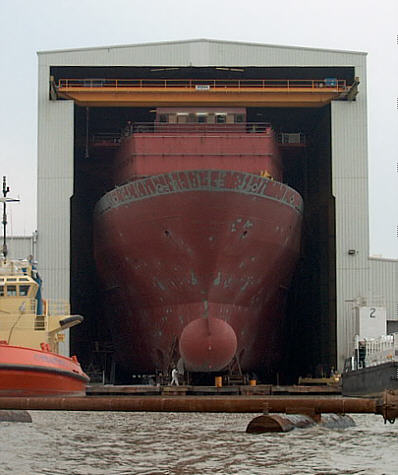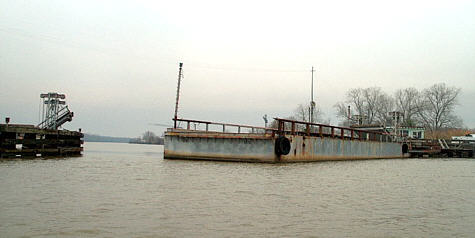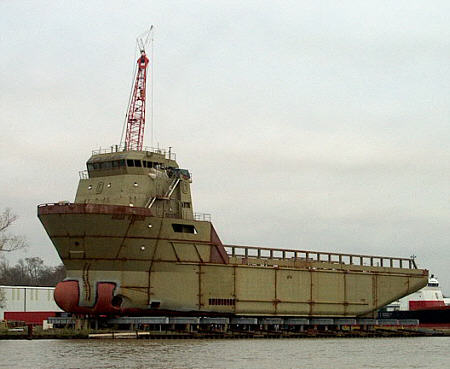|
Near the 50 mm I approach the first floating bridge I have encountered in all my river travels. The bridge structure is built on a barge that is hinged at one corner. Cables are used pivot it towards the shore to allow craft to pass. Not having seen one of these before I stop for a moment and take a look. I then try to contact the bridgetender on channel 16 but get no response. While I am fumbling with the radio the bridge begins to open. In a few minutes I and signaled through and continue on my way towards Morgan City.
The final barrier I would need to conquer before ending the day was Bayou Boeuf Lock at mm 93. Quimby’s describes this as normally a no lift lock that is designed to prevent salt-water intrusion in to the rest of the river system. It also states that the lock can be avoided (although adding ten miles to the trip) by using the Bayou Chene bypass. I decided to avoid the lock and take the bypass.
But there was a problem - remember, I don’t have a chart. But how hard can it be to find the bypass? Yea, that’s what I thought. On the GPS I found the Bayou Chene so assumed it would lead me to the bypass I ran about 4 miles before I came to the conclusion I was wrong. I spent about 10 minutes scrolling back and forth on the GPS trying to make sense of things but no luck – I just couldn’t find it.
Not good. The sun faded and the sky went to black as I waited. When I finally entered the lock I found that the sides were not the normal going in all directions.smooth concrete but rather constructed from 12” square timbers spaces about 12” apart. My fenders would easily go between these allowing the hull to scrape against the side so I needed to stand and physically hold Therapy off the wall. Plus rather than just passing through we actually were being lifted about 3 feet.
This made the lockage longer but at this point it really didn’t make any difference. The daylight AND twilight was gone. I wasn’t looking forward to coming out the other side and making my way to Morgan City in the dark with all the commercial traffic moving up and down as well as across the river. But I had two things going for me. First, it was only about 2 miles to the dock so even off plane it wouldn’t be a long trip. And the second is something I had failed to mention until now. For Christmas I bought Therapy a nice little gift – a JRC radar unit (1500 MKII).
The lock gates open and the two barges in front of me exit and I follow them out, leaving the well-lighted chamber behind. I find that the area of the other side of Bayou Boeuf Lock is very heavy industrial and lights on both shores are everywhere. One might think that all these lights would be welcome but in truth they are far worse than being in the dark. The first problem is they seriously hamper your night vision. Next, their reflections off the water make it difficult to interrupt the actual shoreline. In this case, it is even worse because the surround land is so low that everything appears to be sitting on the water. But the biggest hitch is the lights disguise the navigation lights on the barges and other boats working in the harbor. It is very difficult to tell what is fix land lights and what is floating or working tows.
Here the radar proves its real value. I am able to pick out the shorelines as well as barges that are moving around the fairly narrow channel. I proceed at about 15 mph holding to the starboard shore and make the passage with no problems. Still I am glad it is behind me and don’t want to do that in the dark again.
|
 From
time to time there were interesting breaks in the expanse of canals and
bayous that came in the form of boat boat/ship building
facilities. Both large and small factories could be seen with
workman busy plying their trade. Rebuild projects as well as
construction of new ships were underway. A few of these were
huge. For size reference notice in the
photo to the right the worker walking in the lower center. Beside one
plant were two 3-story motel type buildings I assume were for the
workers as well as an infirmary
From
time to time there were interesting breaks in the expanse of canals and
bayous that came in the form of boat boat/ship building
facilities. Both large and small factories could be seen with
workman busy plying their trade. Rebuild projects as well as
construction of new ships were underway. A few of these were
huge. For size reference notice in the
photo to the right the worker walking in the lower center. Beside one
plant were two 3-story motel type buildings I assume were for the
workers as well as an infirmary And now the sun was getting low on the horizon.
I decided there was no choice but to take the lock. But the
problem with that decision is the GPS didn’t show it either! I really
expected that there might be a sign or some type on indicator on shore
but I found none. After running down another dead end I
doubled back and finally located the lock. A call on 16 again
brought no response. I tried 14 and the lockmaster came back
informing me I would need to wait for two of the four barges in cue to
lock through (locking two at a time) and then I would be allowed to
enter the lock with the remaining two.
And now the sun was getting low on the horizon.
I decided there was no choice but to take the lock. But the
problem with that decision is the GPS didn’t show it either! I really
expected that there might be a sign or some type on indicator on shore
but I found none. After running down another dead end I
doubled back and finally located the lock. A call on 16 again
brought no response. I tried 14 and the lockmaster came back
informing me I would need to wait for two of the four barges in cue to
lock through (locking two at a time) and then I would be allowed to
enter the lock with the remaining two. Now
I know it is kind of nuts. An 18’ boat with radar?
But too many times in the past I have found myself in a similar
situation and decided to take the plunge. I am still learning
to use it but am getting more comfortable with its operation.
I have logged a little over 300 daylight/good visibility miles training
with it but tonight will be the first real world test.
Now
I know it is kind of nuts. An 18’ boat with radar?
But too many times in the past I have found myself in a similar
situation and decided to take the plunge. I am still learning
to use it but am getting more comfortable with its operation.
I have logged a little over 300 daylight/good visibility miles training
with it but tonight will be the first real world test.